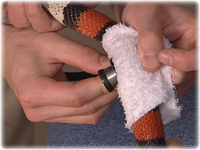Snake Physical Examination
| This article is still under construction. |
Introduction
The physical examination involves observation of the snake, taking measurements and a thorough methodical area by area examination. Many techniques are similar to other animals, but before examining the snake ask the owner if it is accustomed to being handled. See here for information on handling and restraint of snakes. A veterinarian who is inexperienced with reptiles may be likely to focus on the presenting signs but then can end up treating exclusively the secondary problems. Stomatitis and rectal prolapse are secondary conditions where a full examination with husbandry review, including housing and nutrition, is vital in determining the principal problem.
Observation
Snakes should have active tongues that are sampling scent particles in the atmosphere. Normal movement should be observed although allowances must be made for any chilling effect in transit since this will reduce the patient's metabolism and give a misleading impression of lethargy and lack of strength. The righting reflex should be tested since poor reactions can be a result of weakness and not necessarily neurological disease. Respiration, including rib movements and any sounds produced. Be aware of hissing noises arising from agitation that are not a result of respiratory infection.
Body condition
Weight of the snake should be taken at every examination, as should snout-vent lengths. Obese snakes have increased fat deposition on the last third of the body before the cloaca. Cachectic snakes with significant loss of muscle mass show a prominant dorsal spine and ribs, and the body shape looks more triangular in cross section.
